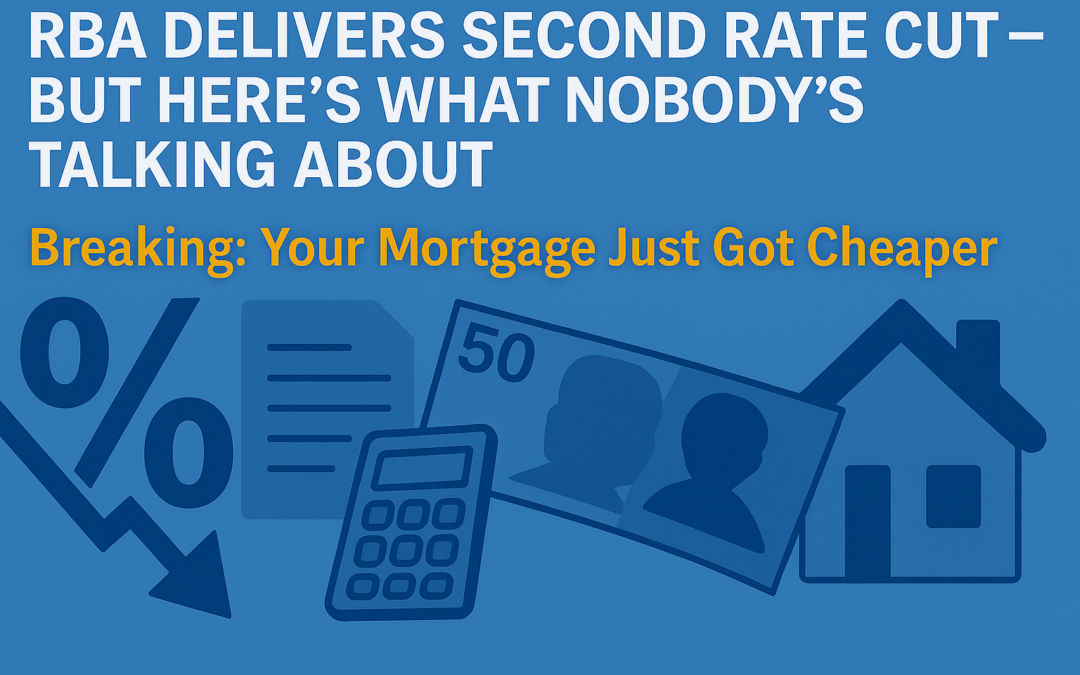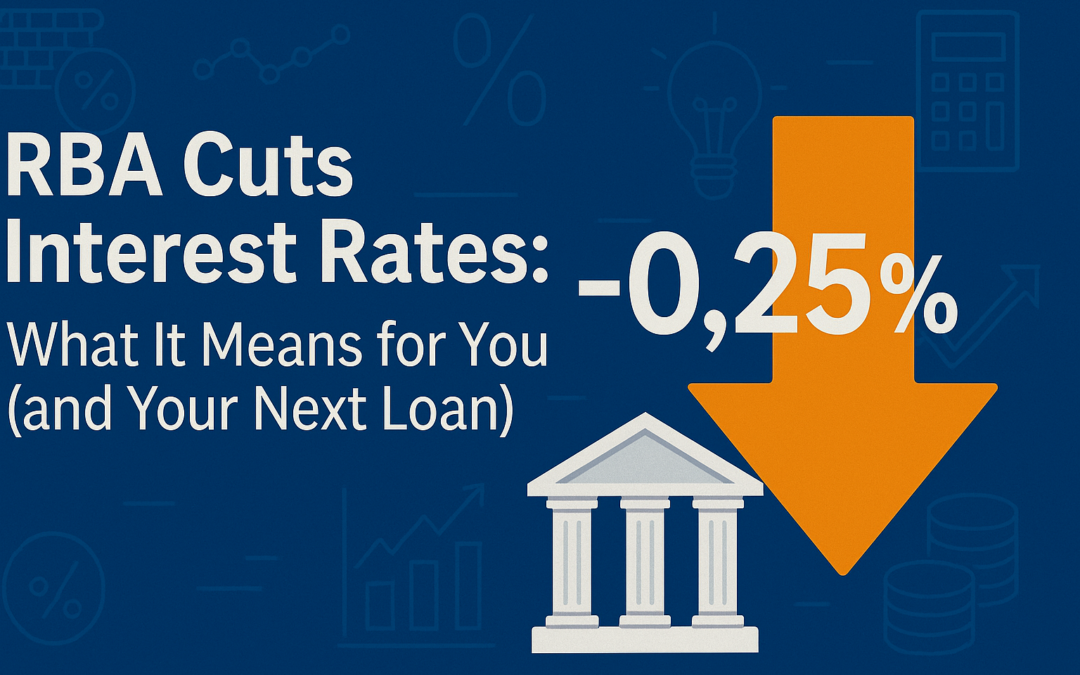
May 30, 2025 | Bridging Loan, First Home Buyers, Investment Property, Property Market, Refinance
Posted May 30, 2025 | By the Sanford Finance Team
Breaking: Your Mortgage Just Got Cheaper Again
The RBA has delivered its second interest rate cut of 2025, reducing the official cash rate by another 0.25% to 3.85%.
What’s particularly noteworthy this time is how quickly the banks have responded – we’re seeing same-day rate cuts from the Big Four. It’s refreshing to see banks move this fast to pass on savings to customers.
Commonwealth Bank: “Done. May 30th. You’re welcome.” NAB: “Same day. Consider it handled.” ANZ: “May 30th. No waiting around.” Westpac: “June 3rd. Close enough to count.”
Even the smaller lenders are getting competitive with some fixed rates now sitting under 5%. It’s creating the most competitive mortgage market we’ve seen in years.
The Real Dollar Impact 💰
Let’s talk actual savings for your household budget:
Got a $500k mortgage? You just saved roughly $81 every single month. That’s nearly $1,000 back in your pocket every year.
Playing in the $1M league? We’re talking $162 monthly savings. Over a year, that’s almost $2,000 you can redirect toward that holiday fund, emergency stash, or just breathing a little easier.
But here’s an important note – some banks require you to contact them directly to adjust your repayments. Don’t assume the savings will automatically appear. Make sure to follow up with your lender.
The Concerning Reality: Mortgage Stress Is Still Rising
Despite the positive news, there’s a concerning trend in the data.
Despite TWO rate cuts this year, mortgage stress is actually going UP. We’re not making this up:
- 63% of mortgage holders are feeling the pinch (that’s UP from 59% last month)
- 1.4 million households are in genuine mortgage distress
- People are missing payments even as rates drop
What’s happening here? The reality is that if you’ve been struggling through two years of significant rate rises, two modest cuts might provide some relief but not complete recovery. The cumulative impact takes time to reverse.
The Tale of Two Australias
The data reveals something fascinating: Australia is splitting into mortgage winners and losers, and it’s not just about income.
The Struggle Streets:
- Craigieburn, VIC: 3.10% arrears rate (triple the national average!)
- Bateau Bay, NSW: Also in the danger zone
- These aren’t necessarily “poor” areas – they’re often filled with families who stretched to buy homes at peak prices
The Opportunity Zones: Meanwhile, savvy borrowers in competitive markets are using this environment to their advantage – refinancing, restructuring, even expanding their property portfolios.
Where You Stand: Three Common Situations
If you’re still struggling financially: Rate cuts help, but they may not be enough on their own. Consider exploring loan restructuring, refinancing options, or temporary relief measures like interest-only payments. Professional guidance can help identify the best path forward.
If you’re managing but it’s still tight: This rate environment gives you an opportunity to get ahead. Consider refinancing to better terms now, while the market is competitive.
If you’re in a strong position: Lower rates create opportunities for investment finance, business expansion, and portfolio optimization. It’s worth exploring how to make the most of this environment.
The Million-Dollar Question: What Happens Next?
Nobody has a crystal ball (if they say they do, run), but here’s what we’re watching:
The RBA is clearly in “support mode” rather than “emergency mode.” They’re not panicking about inflation anymore, which means they’ve got room to move if the economy needs more help.
But here’s the thing – this window won’t stay open forever. Economic cycles turn, global events happen, and what’s available today might not be available tomorrow.
Your Next Steps: Making Smart Decisions
If you’re struggling: Don’t wait for things to improve on their own. Explore your options now while you still have choices available.
If you’re stable: Consider whether you could optimize your loan structure to save more or position yourself better for the future.
If you’re doing well: This market presents significant opportunities for those who understand how to navigate it effectively.
Here’s What We’re Doing About It
At Sanford Finance, we’re not just watching this unfold – we’re helping people win in every scenario.
This week alone, we’ve helped:
- A tradie in Penrith restructure his loans and free up $400/month in cash flow
- A couple in Brisbane refinance and save enough to start their investment journey
- A small business owner in Perth access cheaper equipment finance to expand operations
The difference? They didn’t try to figure it out alone.
Ready to Take Action?
The market conditions are creating real opportunities, but they require the right approach and timing.
Book your free strategy session to review your specific situation and explore the options available in this changing market.
Sanford Finance – Smart Lending Solutions
Disclaimer: This information is general in nature and should not be considered personal financial advice. Individual results vary based on personal circumstances. Please consult with qualified professionals before making financial decisions. But seriously, don’t just sit there – take action.

May 21, 2025 | Interest rates, Investment Property, Property Market
The Wait Is Finally Over
After years of rising interest rates that have tested Australian households and businesses, the Reserve Bank of Australia (RBA) has finally delivered some welcome relief. In its May meeting, the RBA cut the official cash rate by 25 basis points to 3.85% – the first reduction in over two years.
This significant shift in monetary policy marks a turning point for borrowers across the country. But what does it mean for your finances, especially if you’re self-employed or running a small business? Let’s break it down.

Why Now? The Economic Picture
The RBA’s decision reflects growing confidence that inflation is finally under control. Recent data shows that core inflation has returned to the RBA’s target range of 2-3%, sitting at 2.9%. This crucial development has allowed the central bank to shift focus from fighting inflation to supporting economic growth.
Despite global uncertainties – including recent U.S. credit rating downgrades and ongoing trade tensions – Australia’s economy remains resilient:
- Unemployment is steady at 4.1%
- The labour market participation rate is strong at 67.1%
- Economic growth has slowed but remains positive
What This Means for Homeowners
If you’re currently paying off a mortgage, this rate cut could deliver meaningful savings:
- On a $500,000 loan, you could save approximately $76 per month (assuming lenders pass on the full cut)
- On a $1 million loan, potential monthly savings increase to about $152
For those who have been struggling with higher repayments over the past two years, this represents the first real relief in a challenging period. While one rate cut won’t completely offset previous increases, it signals a potential change in direction that could lead to further cuts later this year.
Self-Employed Australians: Your Opportunity Window
If you’re self-employed or running a small business, this rate cut opens several strategic opportunities:
1. Business Expansion
Lower interest rates make business loans more affordable, potentially enabling expansion plans that may have been on hold during the higher rate environment.
2. Equipment and Vehicle Finance
If you’ve been delaying purchases of new equipment, vehicles, or other business assets, now could be an ideal time to reassess. With improved borrowing conditions, asset finance options become more attractive.
3. Refinancing Existing Debt
Many self-employed Australians have been carrying higher-interest debt through the rate hiking cycle. The new environment creates favourable conditions for consolidating or refinancing this debt.
Looking Ahead: Will Rates Fall Further?
While the RBA has made its first move, economists remain divided on the pace of future cuts. Our analysis suggests:
- The next rate cut could come as soon as August, depending on inflation data
- A more conservative scenario would see another cut in November
- By mid-2026, we could see the cash rate settling between 3.0-3.5%
The RBA has made it clear that future decisions will depend on economic data, particularly inflation figures and employment statistics.
How Sanford Finance Can Help
As specialists in lending solutions for self-employed Australians and small business owners, we’re uniquely positioned to help you navigate this changing interest rate environment:
- Home Loan Review: Let us assess your current mortgage and identify potential savings through refinancing
- Business Lending Solutions: Access our network of over 40 lenders who understand the unique needs of self-employed professionals
- Asset Finance: Explore competitive rates on equipment, vehicle, and other asset purchases
- Strategic Planning: Develop a financing strategy that takes advantage of the current rate environment
Take Action Now
The rate cut environment won’t last forever, and taking action now could secure you significant savings over the life of your loans.
Contact our team today for a no-obligation review of your financial position. We’ll provide clear, straightforward advice on how to make the most of this shifting rate environment.
Sanford Finance – Smart Lending for Self-Starters
Disclaimer: This information is general in nature and does not take into account your personal financial situation. It is provided for educational purposes and should not be considered financial advice. Please consult with a financial professional before making any financial decisions.

Aug 8, 2024 | First Home Buyers, Investment Property, Purchasing
Property Share is a simple home loan option that allows multiple people to buy a property together and share the costs, while keeping their finances separate. It’s great for homebuyers and investors looking to refinance or enter the property market sooner.
Let’s break down what Property Share is, the benefits and risks and what you need to consider before applying for this type of loan.
Who is Eligible for a Property Share Loan?
- Available to Individuals, non-trading Companies and/or Family/Unit/Hybrid Trusts.
| Eligible Loan Types |
What you can use this loan for |
What you can’t use this loan for |
– Standard Variable Rate home loan
– Fixed Rate home loan
– Refinance |
– Owner occupied or investment property purchase
– Home renovations
– Consolidation of personal debt
– Off the plan purchases
– Personal needs
– Personal investments |
– Business purposes
– Bridging loans
– Purchase of land
– Building and construction loans |
- To qualify for a property share loan, all borrowers must
- Be owners of the property (no third-party guarantors allowed).
- Guarantee each other’s home loans as security support only.
- Show they can handle the minimum required repayments for their own home loans.
- Get independent legal advice before entering into a Property Share arrangement.
- Sign a Statutory Declaration.
- A maximum of two home loan applications per security is allowed. However each application may have multiple borrowers or multiple loan products (such as a split loan).
The Benefits of Property Share Loans
- Divide property costs as desired; each borrower manages loans and repayments independently.
- Customise home loans to individual needs: choose amount, type, term, and repayment structure.
- Benefits include entering the property market with a smaller deposit and building equity faster.
- Allows investment with multiple parties while keeping finances separate.
The Risks of Property Share Loans
- In a Property Share arrangement, you guarantee repayment of the other borrower’s home loan if they can’t pay.
- If they default, the lender will try to recover the debt from them first.
- As a last resort, the lender may assist in selling the property that secures your loan to repay the debt.
Important Note: Agreeing to be a guarantor and providing a guarantee comes with substantial financial risk. This could mean losing your property (even your family home) or facing significant financial loss. If there’s a default and you must repay the guarantee, it could also hurt your credit score.
Did you know? Each borrower can choose a home loan product that suits their needs. The features, benefits and interest rates of the selected home loan(s) will apply. We will guide you through the different options available and find the best fit for your unique situation.
Ready to Explore Your Options and Find Your Dream Home?
Contact us today via our website or on 02 9095 6888 and talk to one of our specialist mortgage brokers who can help you navigate the process of Property Share Loans and find the best approach for your unique situation.






